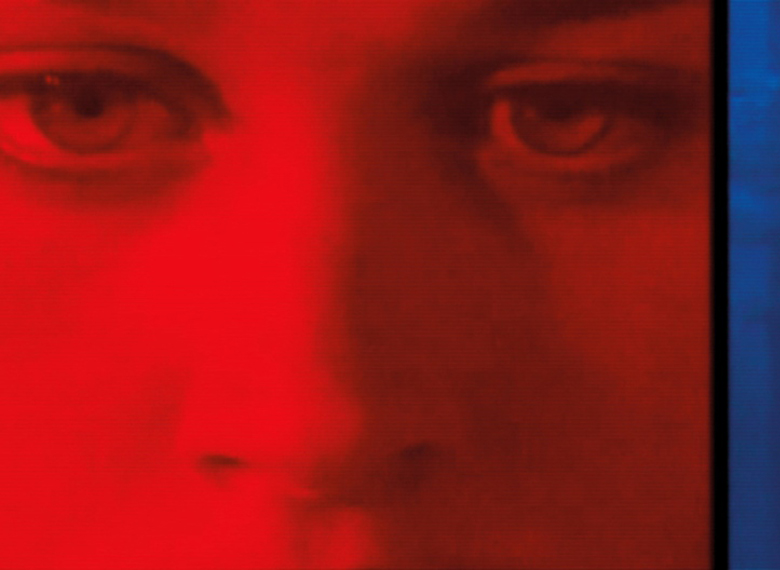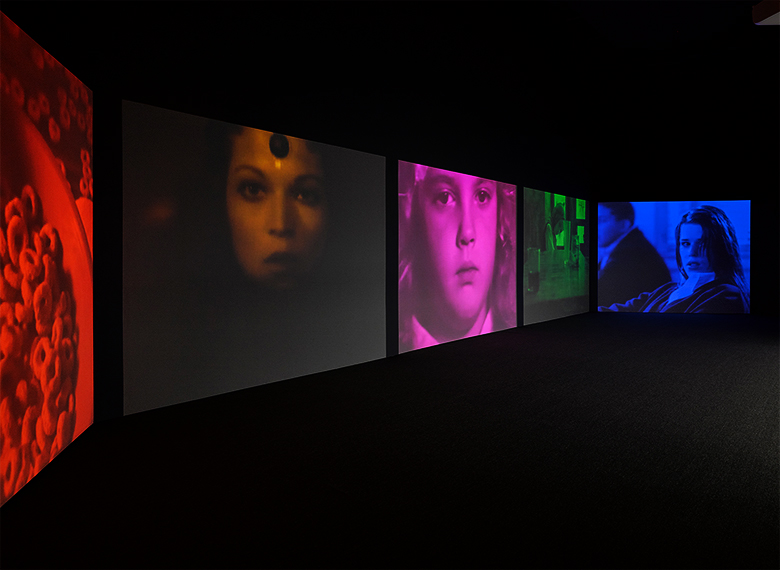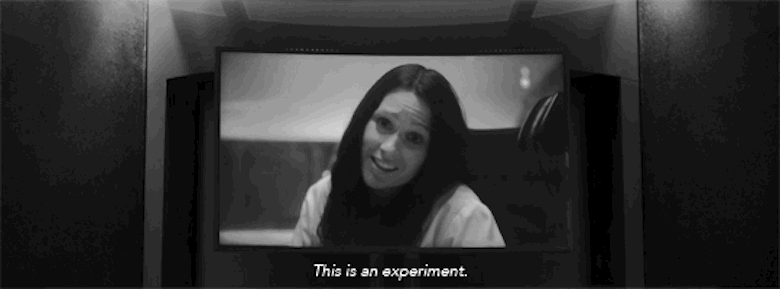I was drawn to Altered States, a recent exhibition of Susan Hiller’s work at The Polygon in North Vancouver, primarily because of its inclusion of her five-channel installation, Psi Girls (1991). I knew very little about it, but was keen to see how Hiller would treat images from popular cinema of young girls with powers. I’m always interested in any kind of image, metaphorical, or otherwise, of a young girl with powers, and how they are positioned as agents for good, evil, or complicated.
Psi Girls is comprised of five scenes projected side-by-side, each portraying a young girl performing a telekinetic act. She cites iconic moments from The Fury (1978, Brian di Palma), The Craft (1996, Andrew Fleming), Matilda (1997, Danny de Vito), Firestarter (1984, Mark Lester) and Stalker (1979, Andrei Tarkovsky). Each screen is tinted a different colour: red, yellow, magenta, green, and blue. The installation is accompanied by a soundtrack that sonorically evolves from silence to accelerated clapping and drumming taken from the recording of a gospel choir. The non-lyrical vocals layer a religious or spiritual tone to the experience of the piece. This accompaniment to the cycle of imagery reinvigorates these moments with the sense of awe that Hiller identifies as a social fixation on this motif in popular media.
In conversation with writer and cultural critic Lynne Tillman last year during Hiller’s exhibition at Lisson Gallery New York, the artist reflected on the how she used the term "paraconceptual" as a critical framework to make work that deviated from received ideas of conceptual practice. She introduced her term “paraconceptualism” at a talk in the seventies at the Women’s Free Art Alliance as the framework that could exist “beside” the conceptual movement in the UK at the time, which was driven by language.1 “Para,” which is Greek for “beside,” connotes being beside the conceptual. Hiller, who has a background in linguistics and anthropology, positions this practice as marginal or liminal, but ultimately tethered to conceptual practice—“The work would be conceptual but it would have a decentralized element to it,” she explains, “I began to work entirely with ideas that were already present in the culture but were ridiculed, neglected, misunderstood etc...”2
Contemporary art discourse demonstrates a consensus about caging these images of young girls with super powers within a libidinal metaphor.
However, the prefix, “para” has apparently created some confusion when it has been conflated with Hiller’s work that visually references paranormal matter, such as spectres, auras, and telekinesis. So while at first glance, her works may convey occupations with the realm of belief and how it can be dealt with in art, she clarifies that the paraconceptual has been used in her practice to trace a social fascination with deviations from the norm in order to forward the notion that these fascinations are what French sociologist Emile Durkheim calls “social facts.” Social facts are established by observing the universal behaviors of a society and how that behaviour conveys that society’s values.3 Hiller doesn’t explicitly state this in her conversation with Tillman, but the conceptual art movement of the sixties and seventies was not only driven by language, but by men. Therefore, the paraconceptual resonates when looking at her work from the time this term was introduced, through to the present, as a conceptual refuge—beside, but still within the dominant, received modes of working in the art world.
Hiller said to Tillman, “Psi Girls deals with this sort of obsession with special powers of some human beings, in this case, of girls—now that’s a social fact.”4 Once a clip in Psi Girls has elapsed, it reappears on the screen beside it and the sound and image begins anew, rearranged. The viewer is minimized relative to the sounds and size of the image, and the edifice of the work has the atmosphere of a pantheon where we might pay our respects—but to what do we submit to, this obsession as social fact, or the image of adolescent power? Hiller states that it isn’t a question of starting a conversation, of excavating any truth factor behind these kinds of manifestations, in this case, of telekinesis. “I mean obviously it’s special effects, but there is a history of belief that gets exaggerated because [the powers are] represented so literally in media.”5 Does Psi Girls reproduce the social fact of that history of belief? And if it does, what does that social fact determine, twenty years after the media phenomenon?
A couple of recent passages are fixated on a particular interpretation of Hiller’s proposition of a social fact. In her 2011 catalogue, published to accompany her exhibition at the Tate Britain, art critic Christopher Turner wrote of Psi Girls:
Susan Hiller describes these clips as a ‘moment of pleasure.’ She strips away the rest of the film to leave only the uncanny remainder. The filmmakers sentimentalise and idealise the visionary qualities of childhood, present us with an exhilarating world of plenitude that is lost to adults. But Hiller assembles them alongside each other and the footage takes on a new meaning, signifying the threat of unchecked female desire and the subversive violence of adolescent sexuality.6
From The Kunsthalle Nürnberg’s catalogue in 2012, Susan Hiller: From Here to Eternity:
The near-critical mass of examples of such scenes from genre films . . . proves that they reflect a collective fantasy concerning adolescent girls. It is a fantasy that may be characteristic of puritanical societies like that of the United States: the notion (experienced as either threatening or exciting) of the overwhelming power of the seemingly weak. And what could have given teenage girls this power (and this of course an unspoken element of the fantasy) if not their as-yet incompletely developed and deployed sexuality?7
In 2015, a Frieze article written by critic Brian Dillon:
The blatant sublimation of unruly sexual energy into psychic powers may be a horror-movie cliché, but in Psi Girls it is also revealed to have lurid affinities with an earlier archetype: the stage-managed images of Victorian ‘hysterics.’8
What these passages communicate is that when we are shown adolescent girls displaying powers of unknown origin, we still see metaphors for burgeoning sexuality—we see horny little girls—as a liability. Contemporary art discourse demonstrates a consensus about caging these images of young girls with super powers within a libidinal metaphor. Hiller’s installation is a material anchor that allows the presentation of social facts to circulate as art. But the edifice becomes irrelevant, falls away. A steady engagement with the social function of these images charts an incredibly unchanged and internalized misogyny in the sexually reactionary, and relatively recent, interpretations of this work. Texts mark how images of young girls with powers have been officially received through the forty year lifespan of this motif.
In the period between visiting the exhibition and writing this text—a fairly truncated timeline—I encountered two very recent examples of mainstream popular culture that seem to depart from this social fact of the sexual awakening manifest as nascent superpower. Plots rather revolved around the release or escape of a woman who was imprisoned because their ambition or intellect posed an apocalyptic danger to society. Hela, Goddess of Death, in Thor: Ragnarok (2017, Taika Waititi) and Eurus Holmes, from the last episode of the Sherlock Holmes series (2010-2017, Benjamin Caron), were both incarcerated by their fathers or brothers upon the identification of their “unchecked female desire” to surpass the men in their lives. These women are given as antagonists to the state of relative serenity or balance in the film’s world. They are the adult images who inherited the cited readings of Hiller’s Psi Girls, grown up to be imperialists, or psychopathic criminals. However, if the factor of age remains, and we look at more evenly gendered portrayals of young characters with superhuman abilities, they are given as outsider-saviours, such as the popular television series, Heroes (2006-2010), or as moral tales, like Chronicle (2012, Max Landis), which follows three teenage boys who gain telekinetic powers after being exposed to a mysterious substance. This culminates in a massive fight scene involving catastrophic infrastructural damage in downtown Seattle, yet, this clash is rooted in teenage angst, not a power hungry flex fest. The plot has nothing to do with sexual frustration whatsoever, even though the confidence the main character gains from having sudden superpowers gets him laid.
Against the art historical context Hiller emerged from, paraconceptualism was a clever feminist reflex, a rhetorical acrobatic with which to non-explicitly carve space for the practice of women artists, so artists like herself could make art under the sign of paraconceptualism, but not feminism.
Young women have always required an exceptional quality in order to enter into an arena of legitimation, to be taken seriously, or necessarily enter into the collective imagination as an agent of unchecked power in opposition to male hegemony. This is why the official readings of Psi Girls were troubling, but also obvious and underwhelming. We all know that any kind of fear women, at any age, inspire in men is not treated with so much adulation as threat, either to be sequestered or conquered. So, with paraconceptualism, Hiller identified a social fact, that of the language movement of conceptual art in her contemporary moment. Against the art historical context Hiller emerged from, paraconceptualism was a clever feminist reflex, a rhetorical acrobatic with which to non-explicitly carve space for the practice of women artists, so artists like herself could make art under the sign of paraconceptualism, but not feminism. Under paraconceptualism, she can operate non-threateningly and in plain sight among her male contemporaries, but again, “para” or beside. Hiller’s lack of feminist follow-through informs me that Psi Girls is a document with outcomes that prompts the audience to investigate the social context of its making. But through a full dialectical turn, the information this work conveys demonstrates the supranormal (beyond normal) that trawls the underbelly of “collective fantasy” as pure and docile thought-experiment—where the experience of art ends, social facts remain unmoved.
Psi Girls is part of the exhibition Altered States by Susan Hiller that will be showing at The Polygon (Vancouver, BC) until September 2, 2018.






